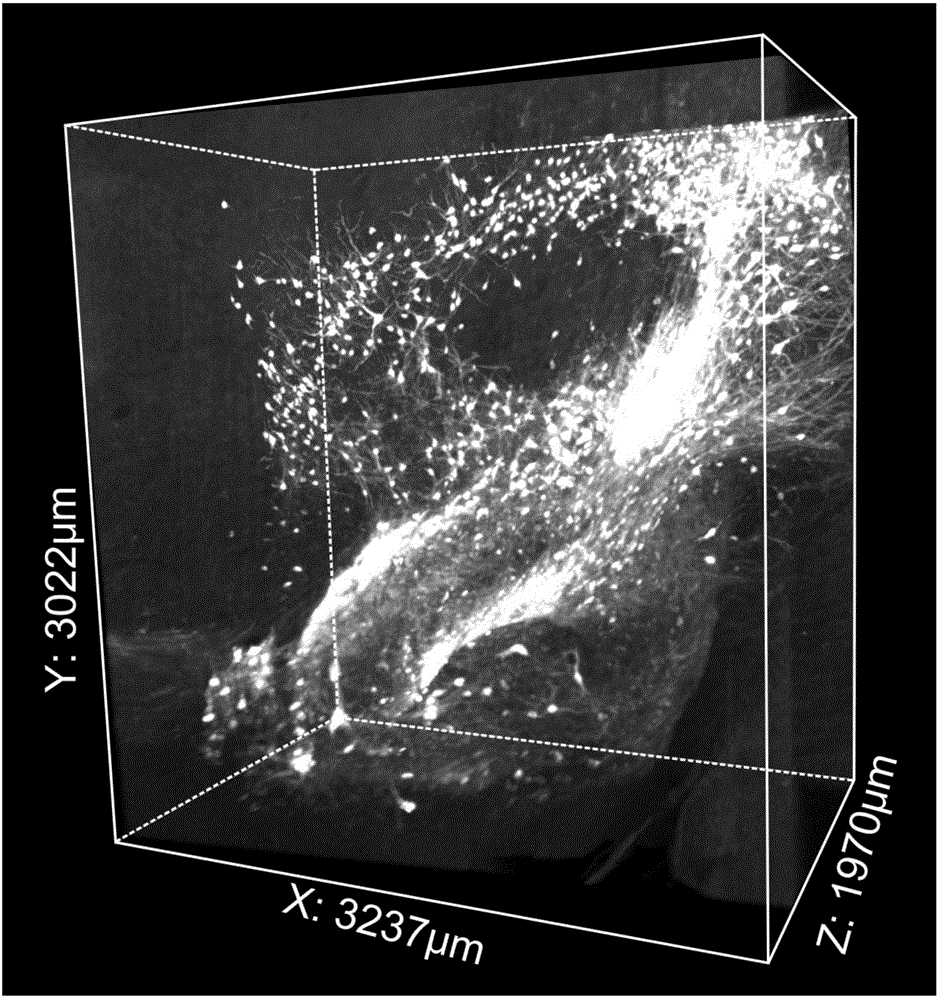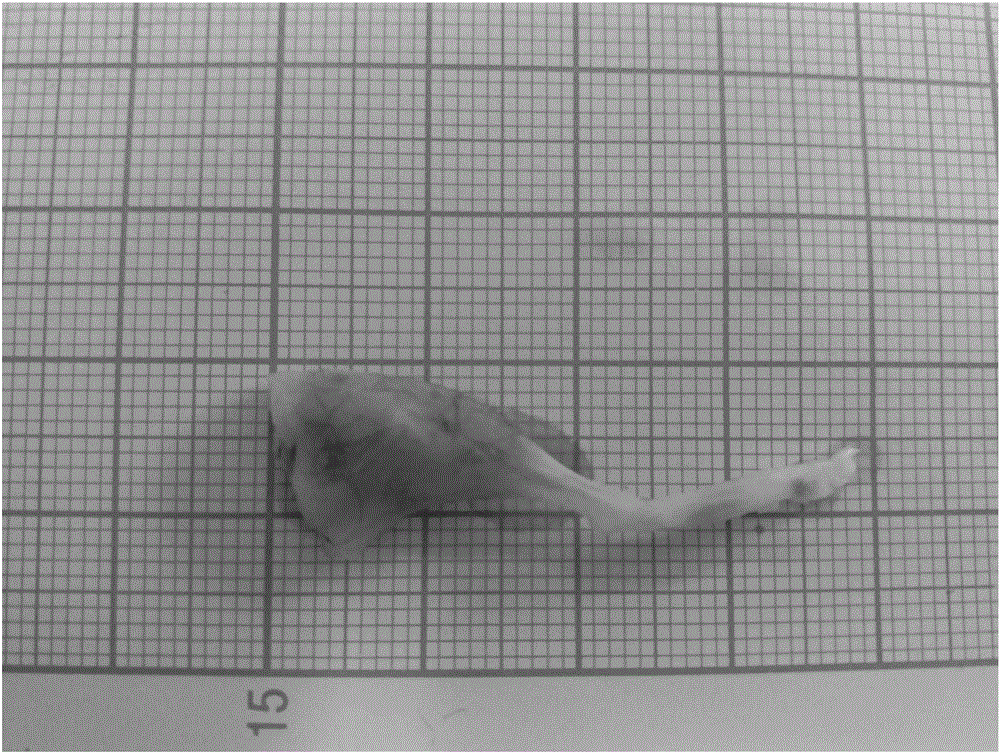Method for optical clearing of biological tissues
A biological tissue, aldehyde compound technology, applied in fluorescence/phosphorescence, material analysis by optical means, material excitation analysis, etc., can solve the problems of poor repeatability, slow transparency, and low degree of transparency. The effect of the original morphology, maintaining the original morphology, and cheap and easy availability of reagents
- Summary
- Abstract
- Description
- Claims
- Application Information
AI Technical Summary
Problems solved by technology
Method used
Image
Examples
Embodiment 1
[0070] (1) The 3000 μm mouse brain block was fixed by chemical fixation method, and fixed with 4% paraformaldehyde at 4°C for 24 hours;
[0071] (2) Rinse the fixed mouse brain block with PBS buffer solution for 12 hours, and then carry out immunohistochemical fluorescent labeling. First, use 20% DMSO and 1% triton X-100 to punch holes for 12 hours, and then add serum Incubate for 12 hours, then add primary antibody and incubate for 48 hours, rinse for 1 hour / 3 times, then add secondary antibody for 8 hours, rinse for 1 hour / 3 times;
[0072] (3) Dehydrate the immunohistochemically labeled mouse brain blocks with tetrahydrofuran, and dehydrate according to 50% tetrahydrofuran / 2 hours+75% tetrahydrofuran / 2 hours+95% tetrahydrofuran / 2 hours+100% tetrahydrofuran / 2 hours+100 % THF / 12 hour program for gradient dehydration;
[0073] (4) Put the dehydrated mouse brain block into a strong polar aprotic solvent 1,4-dioxane, and place it at room temperature in a dark environment for im...
Embodiment 2
[0078] (1) The legs of mice were fixed by chemical fixation means, and fixed with 4% paraformaldehyde at 4°C for 24 hours;
[0079] (2) Dehydrate the fixed mouse legs with ethanol, dehydration according to 50% ethanol / 2 hours+75% ethanol / 2 hours+95% ethanol / 2 hours+100% ethanol / 2 hours+100% ethanol / 12 hour program for gradient dehydration;
[0080] (4) Put the dehydrated mouse legs into the strong polar aprotic solvent 1,3-dimethyl-2-imidazolidinone for 48 hours at room temperature to avoid light and degrease until the biological tissue is translucent;
[0081] (5) Put the degreased mouse legs into the refractive index matching reagent for transparent treatment. The matching reagent o-dichlorobenzene (refractive index 1.55-1.552) is immersed in the dark for 24 hours at room temperature until the biological tissue is transparent ;
[0082] (6) Take pictures of the cleared mouse legs.
[0083] Figure 3 is a comparison diagram of the effects before and after the transparency ...
Embodiment 3
[0085] (1) The whole brain of the mouse was fixed by chemical fixation method, and fixed with 4% paraformaldehyde at 4°C for 24 hours;
[0086] (2) The whole mouse brain was dehydrated with tetrahydrofuran, dehydration according to 50% ethanol / 2 hours+75% ethanol / 2 hours+95% ethanol / 2 hours+100% ethanol / 2 hours+100% ethanol / 12 hours The procedure for gradient dehydration;
[0087] (4) Put the whole brain of the dehydrated mouse into a strong polar aprotic solvent for degreasing treatment. The degreasing reagent N-methylpyrrolidone (NMP) is placed at room temperature and immersed in the dark for 48 hours until the biological tissue is translucent. ;
[0088] (5) Put the degreased mouse whole brain into the refractive index matching reagent 3-phenoxybenzyl alcohol (refractive index 1.592-1.594) for transparent treatment, and immerse it in the dark at room temperature for 12 hours until the biological tissue Transparent;
[0089] (6) Take pictures of the cleared mouse whole br...
PUM
| Property | Measurement | Unit |
|---|---|---|
| refractive index | aaaaa | aaaaa |
| refractive index | aaaaa | aaaaa |
| refractive index | aaaaa | aaaaa |
Abstract
Description
Claims
Application Information
 Login to View More
Login to View More - R&D
- Intellectual Property
- Life Sciences
- Materials
- Tech Scout
- Unparalleled Data Quality
- Higher Quality Content
- 60% Fewer Hallucinations
Browse by: Latest US Patents, China's latest patents, Technical Efficacy Thesaurus, Application Domain, Technology Topic, Popular Technical Reports.
© 2025 PatSnap. All rights reserved.Legal|Privacy policy|Modern Slavery Act Transparency Statement|Sitemap|About US| Contact US: help@patsnap.com



